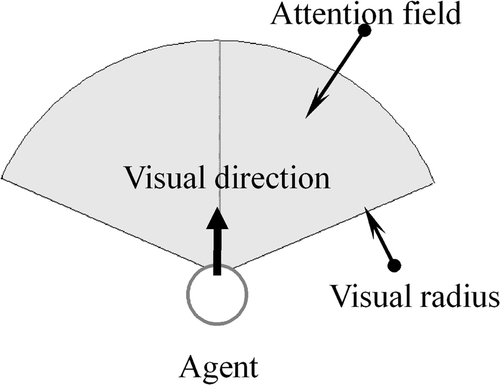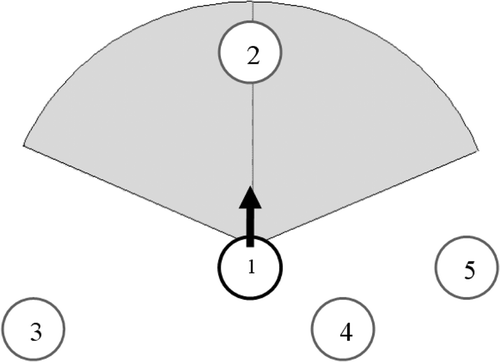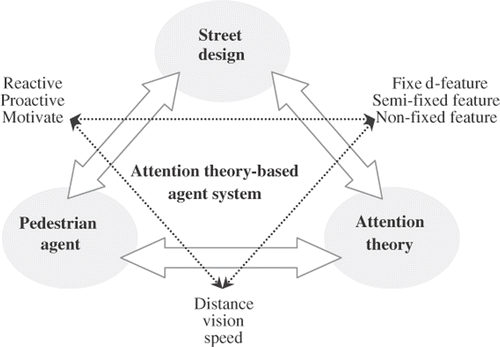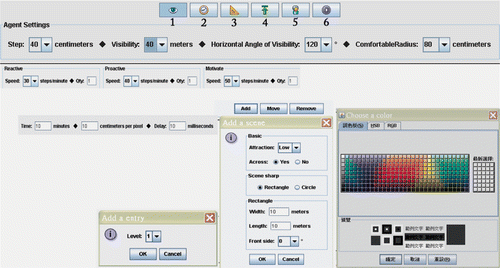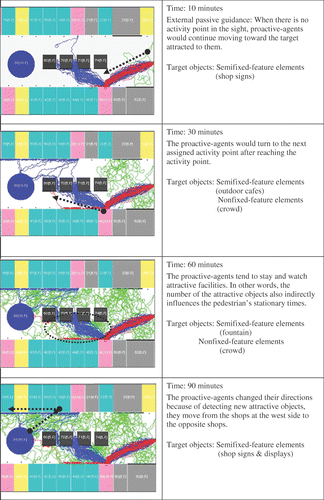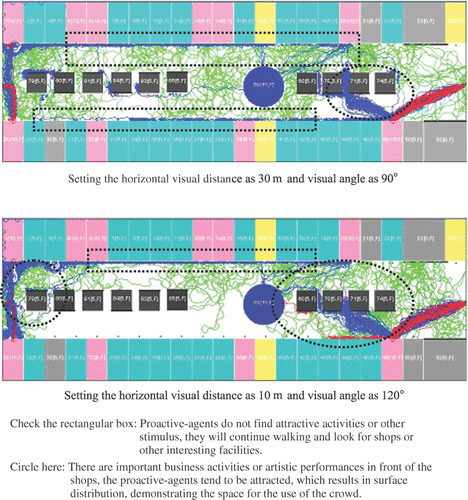Abstract
Pedestrians’ movements and spatial cognition in urban environments are main issues for urban designers in urban spatial planning and analysis. Past studies related to pedestrians mostly focused on crowd aggregation, and only described regular movements. However, the varied outcomes of crowds due to interactions between individuals and environments require further exploration. Therefore, this article aims to study interactions between a behavioral model of pedestrians and urban spaces, and regards micro-scale urban spaces as its target. This article suggests constructing and analyzing a pedestrian behavioral model using the ‘Attention Theory’, and introducing the rules and attributes of agent behavior oriented simulation. Based on the validation of actual street cases, the findings show that (1) the platform constructed by this study is proper for simulating a model of a window-shopping pedestrian, with accurate behaviors and movements; (2) stopping, and walking movements of pedestrians on urban streets can be interpreted as actual behavior induced by internal demands and the stimulation of external environments. The pedestrians can be represented by an agent program, and behavioral reactions of walking agents under different stimuli can be further simulated. Thus, this study suggests that a correlation study on pedestrian behaviors and spatial environments should become the criterion for urban street designers in order to help them create better flows.
Keywords:
1. Introduction
Spatial cognition and pedestrian movements in cities are important issues for urban designers in spatial planning and analysis. Generally speaking, a pedestrian's behavior and spatial selection are influenced by current environmental information and past spatial experiences. Thus, how do pedestrians choose spatial selections when they have activities in complex urban spaces? When selecting a space, what influences the pedestrian's spatial cognition to make a spatial selection? These are interesting issues for further study. This study concerns methods of an individual's spatial cognition when targeting information, including acquisition, organization, saving, and memorization. The information includes locations, distances, and spatial arrangements of an environment; the designers must determine an individual's methods of regarding environments through their spatial cognition; thus, designers must recognize the main influences of elements in urban spaces, based on a pedestrian's individual cognition, and how elements of the space affect their spatial selections.
Present studies on individual models of pedestrians can be divided into three categories: (1) the first category concerns the geometric attributes of movement; (2) the second category aims to explore the correlation between the itinerary and destinations of a pedestrian's movements; and (3) the third category treats spatial cognition as the research orientation method. However, there are few models integrating the issues of these three aspects (Batty Citation2001). The construction of a pedestrian model is associated with spatial structures, important locations, and spatial cognition. These factors also reflect the issues of urban design. Spatial structure involves the characteristics and limitations of the present space. For example, geometric features of streets tend to be the base of urban spatial limitations and developments. Important locations are the centers of urban activities and spatial cognition is related to the users and their spatial experience. By integrating the three aspects, the simulation of design projects can be more complete. According to the spatial scale, the study of pedestrian movement models includes both macro and micro levels and the factors and research directions of the models differ. For instance, Helbing et al. (Citation2001) targeted a physical model of particle flow and led the agents to have rich behavior by simple rules. The ‘STREETS’ model of Schelhorn et al. (Citation1999) assumed that the pedestrians’ movement is influenced by both spatial structure and local attractiveness. They apply social and economic data as the quantitative base of the pedestrians’ movement in the cities to construct different agents’ possible itineraries. The ‘SimPed’ model of Jiang (Citation1999) constructs the basic framework of the model by environmental psychology and spatial syntactic principles and analyzes vision as the base to construct sight scope and sight distance. The said researcher assumes that the vision represents all possibilities of walking, leads to the pedestrians’ selection of the next walking choice and further establishes the relationship between the pedestrians’ movement and spatial structure. However, the above-mentioned studies only targeted on different pedestrian movements, according to different destinations, which further influences overall flow, and did not explore the design-oriented spatial meaning.
In addition, the study of individual behavior simulation in the computer animation field is common and the most common one is Reynolds’ (Citation1987) Boids Model simulation, which is based on three types of virtual forces: separation, cohesion, and alignment; thus, the Boids Model can maintain speed, distance, and show group movement. Reynolds (Citation1999) extended the original model by adding features, such as seek, and flee, pursuit, wander, and obstacle avoidance. When these behaviors are integrated, they become a complicated system. Helbing and Molnar (Citation1995) established a pedestrian dynamics model, which proposes the concept of social force. The agent's movement relies on the interaction of four types of force: (1) self-driven to destinations; (2) separation to avoid others; (3) separation to avoid walls; and (4) attractiveness to exits. Helbing et al. (Citation2000) simulated panic escape by social force and the result shows that the people block the door in an arc, which matches reality. These researchers suggested that an increase of exits does not significantly improve panic escape. Borgers and Timmermans (Citation1986) predicted pedestrian movement through gravity models in Markov chains. Saunders and Gero (Citation2004) extended Helbing's social force with the addition of the curiosity theory (Berlyne Citation1960). After each interaction, agents will accumulate their curiosity and apply it to others. The figures influence the agent's group movements, and lead to complicated behaviors. We thus apply this model in the design evaluation of exhibit space.
As discussed, past studies on pedestrians’ spatial movements’ selection were in the scope of an individual's serial spatial selection. The conditions of this kind of model refer to an individual's space with complete information. However, in reality, individuals’ understanding of the environment differs due to their degree of cognition, and thus, the research findings tend to be extremely different from reality. This misdirection leads to researchers looking for an individual's decision-making process through cognitive behaviors. Therefore, this article intends to study the influence of a pedestrian's spatial cognition on spatial selection. A popular shopping street, Jingming Street in Taiwan was chosen as an experimental environment for the research. From the perspective of the pedestrians, we applied the ‘attention’ theory and integrated street space design knowledge and agent behavior. The purposes for construction of the model are: (1) exploring the influence of the pedestrian's spatial attention on the selection of spatial activities and (2) exploring the correlation between the pedestrians’ movement, the behavior model, and design of spatial locations. The order of this article is as below: Section 2 describes related theories, and defines agent behavior and attention; Section 3 is case studies; Section 4 elaborates on the module interface of the system; Section 5 discusses the results of simulation; and Section 6 offers the conclusion and suggestions.
2. Definition of agent behavior and attention
The pedestrian design in this article is based on individual design. The characteristics of agent behaviors and guidance of attention in the space are described below.
2.1. Agent technology
The pedestrian's movement simulation is included in the city simulation. We initially constructed an observable virtual environment in a computer program as the specific target or plan in reality. The agent technique is presently an important research field of ‘artificial intelligence’. From the end of the 1970s to the early 1990s, research focused on the study of software programs using the agent theory. In 1977, Hewitt (Citation1977) initially proposed the self-organized, interactive, and parallel software module, calling it Actor, which became the initial thought of the software agent. Gasser (Citation1991) proposed the macro agent, which targeted the agent's social capacity. Acting on social mechanisms, the agents exchanged information with others to fulfill shared missions and gradually filled out a complete framework, including theory and language. Wooldridge (Citation2002) suggested the concept of an agent community, which was launched in the 1980s. In the mid-1990s, liberated distributed computing and the Internet became knowledge tools of computing and information communication. Multiple agent systems were further developed (Wooldridge Citation2002), highlighting the importance of controlling agent behaviors, while offering the agent intelligence to support users, thereby becoming a key agent technical development.
In terms of cognitive psychology, a key of attention refers to the distribution of mental activities regarding certain things. American psychologist James (Citation1890) indicated that the theory of the key of attention was to ‘sacrifice some things in order to more effectively deal with others’. British cognitive psychologist Broadbent (Citation1958) proposed the ‘filter theory’ to elaborate the process of individual information filtering, including a selective filter, a limit-capacity channel, and a detection device. He suggested that a key of attention was a selective filter, comparable to the human mind's ability to process information, and a communication/attention system complete with a filter for unnecessary stimulus or interference of other individuals. With regard to vision, attention is an extremely important mechanism for coping with information. The psychologist Berlyne (Citation1976) suggested that humans and animals tend to be interested in things that are neither too simple nor too complicated. In other words, in order to increase attention, we must increase the motivation. In addition, over 80% of a human's perception toward external environments is delivered by vision (Merrill et al. Citation1996). With vision, we recognize distances and human activities in an environment. The characteristics of some visual information are easily received by the visual system; however, the information is not accepted to the same degree because humans do not passively perceive and receive external environmental stimulus; instead, it is a dynamic process of information acquisition and environmental exploration.
Human spatial information includes three categories; location, attributes, and time (Passini Citation1984, Chen and Stanney Citation1999). Through the integration of perceived information and knowledge, spatial knowledge allows us to move in spatial environments. This process leads to a triangular relationship of spatial cognition, as suggested by Krieg-Bruckner et al. (Citation1998). With spatial cognition, we can recognize a space and successfully move within it (Spencer et al. Citation1989, McAndrew Citation1993). Such capacities are frequently divided into two types of spatial factors (Darken Citation1996), namely vision and orientation. Vision is related to the psychological capacity to control visual stimulus, whereas orientation is related to understanding the element arrangements of the visual stimulus.
Based on the above, this article assumes that pedestrian movements in urban spaces can be regarded as a ‘stimulation/reaction’ model. The walking agents are interested in the stimulus of cities and have different reactions. They proactively explore environments from different angles, resulting in different behaviors. Environmental information is related to pedestrians’ useful acquisitions and vision. The interaction between cities and pedestrians is as between vision and image. When pedestrians move in a space, they continuously detect their surroundings through the feelings and perceptions of their changing positions. In other words, walking agents can perceive the streets and determine cognitive evaluations to influence their environments. For instance, an agent's perceptions refer to the stimulus of attention from the streets, whereas ‘actions’ mean the walking agent's capacity to influence their environment.
2.2. Guidance of attention in a space
Attention studies have targeted internal processes to examine a human's ability to select and distribute cognitive resources. On the contrary, they rarely explore how attention influences the output of the behavior system or reaction proposed in this study. In short, attention is based on spatial selection, which is referred to as space-based attention. However, according to the experience of daily life, occasionally the targets we give attention to or select are objects instead of simple spatial location, and are thus called object-based attentions. In the early 1980s, studies that explored the characteristics of attention by spatial orientation tended to define attention as a kind of spotlight model. Thus, many studies have proposed the orientation characteristics of attention, particularly the methods to activate attention; ‘endogenous orienting’ and ‘exogenous cuing attention’. Scholars have proposed extremely different views on the influence of the two orientations regarding movements of attention. For instance, Egly et al. (Citation1994) suggested that endogenous orienting tends to result in space-based attention selections. However, Goldsmith and Yeari (Citation2003) offered new suggestions, one of which was their conclusion based on exogenous cuing attentions (attention focusing hypothesis). Based on this hypothesis, in experimentation of exogenous cuing attentions, prior to the cue, participants must maintain a large scope of attention because they could not predict targets in advance. Attention distribution certainly includes the targets that lead to object-based selections.
According to physical limitations of humans (Sanders and McCormick Citation1993), this article sets the agent's visual field at 90–120°. The definition of visual field is as shown in . For example, in , No. 1 is the moving agent with one solid line vector, which refers to the agent's speed and direction. In the visual field, No. 1 agent can see No. 2, and thus, there is drive between them. No. 3, 4, and 5 agents are out of the visual field, and are therefore less likely to draw the attention of No. 1 agent.
3. Case study – shopping street
Shopping street has unique characteristics. ‘Jingming 1st Street’, the target of this article, is located in the 5th rezoning area of Taichung City, Taiwan, as seen in . In terms of urban structures, the east side is the old downtown, and the west side is the administrative center of the new city. The location is critical for connecting different areas. Jingming 1st Street runs in a south-north direction, and the businesses involved tend toward food (22.5%) and clothing industries (55%). There are 42 shops within the surrounding buildings. Thus, Jingming 1st Street, which is mainly based on open-air walking space, has positive climatic conditions for pedestrians. The width of the street is 8 m. Since there are 4 m for the porches of the surrounding buildings, the actual width is 16 m, and the length is about 130 m. For the pedestrians on both sides, rain shower awnings have been installed above the windows and shop signs to create a natural shopping space.
Figure 3. The good place on Jingming 1st Street. (A) Outdoor seats in front of shops. (B) The sound of the fountain. (C) Performances on the sidewalks in front of the shops.
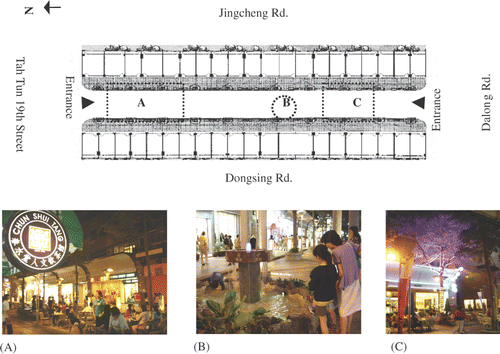
3.1. Observation and analysis of pedestrian
Arthur and Passini (Citation1992) indicated that studies on the relationship between human activities and space information can provide a general principle for design in environmental planning. However, these types of study must collect sufficient data, which is not easy. Since in a real environment, observation of human behavior requires a lot of time and energy; it is also quite difficult to accurately identify the main factors of human behavior. Business activities of different natures are gathered on streets; hence, a wide difference of crowd activities exists. Business types determine the nature of activity; whether businesses of the same or similar nature gather on the same street also determines the characteristics of the street itself. This study adopted the famous business and recreational streets in Taiwan as the simulated environment to observe the behaviors of pedestrians in the street space. By employing the surface atlas recording and analysis to record the behavioral modes of the subjects, this study conducted indirect observations, such as illustration, photographing, and video-recording. Two methods were adopted for observation: (1) follow the pedestrians, photograph and record the important tracking observations; (2) conduct important fixed-point observation on a certain pedestrian in a surveyed area street space in order to obtain the tracking atlas of the moving process. The main purpose is to observe the interactive behavior between pedestrians and street environment, and survey the types of information produced by the environment that the pedestrians would notice when walking on the street. The data were recorded for analysis, and generalized as follows:
-
Crowd collection: From the videos showing the locations where pedestrians halt and the routes of pedestrians, it was found that every location has its own attraction for its unique surrounding environments and furniture. Consider A from ; for example, it is easier for shops with outdoor coffee tables and seats to attract pedestrians and form a stationary point.
-
The location and distance of furniture which attract pedestrians’ attention: Take B from ; for example, fountains can easily become objects which attract pedestrians’ attention or visual focuses. Therefore, elements such as the relationship between fountains and street environments, the distance at which the pedestrians who are attracted stand, size and location of the fountains as well as the possibility of attracting people and diverting crowds all affect the attraction of fountains in street space.
-
Dynamic activities: A and C in are taken as examples here. Their similarity is the business behaviors and performances which often take place on the sidewalks in front of the shops, and this generates crowds. Therefore, interesting street performances which attract pedestrians’ attention could possibly increase the attraction of the locations where performances are made.
-
Shop signs: In addition to the original functions of the streets, diversified advertisement signs and different types of products displayed in arcades can easily build direct conversational relationships with pedestrians, who tend to pay attention to novel furniture; as a result, colorful, bright, large furniture with effects such as unique shapes, textures, surrounding environments and dynamic presentations can easily attract people's attention and generate crowds.
Moreover, in ‘A Pattern Language’, Alexander (1977) suggested that the pedestrian density suitable for a lively place is 0.036–0.072 people/m2. The average number of pedestrians on Jingming 1st Street from 5 pm to 9 pm on weekends is 140; with the measure of the area: 2080 m2, the average pedestrian density of Jingming 1st Street is approximately 0.067 people/m2, which is close to the top end of the suggested density and therefore is enough to generate interactions between pedestrians.
3.2. Stimuli on Jingming 1st Street
Substantial objects can lead to specific behaviors, and thus, they are part of the environmental supply, which directly or indirectly deliver information to the people. According to individual demands, people perceive and adapt to environmental supply. In the street environment, the people's behaviors are maintained and operated by fixed, semi-fixed, and non-fixed objects, which can be treated as the information in the environment. People thus recognize the information, and furthermore have interactions, behaviors, and action matching the scenarios. Thus, the information of the street design is critical with respect to the meaning of a communicative environment and behavioral rules. This article follows the concept of Rapoport (Citation1982, Citation1987) and reorganizes the stimulus of Jingming 1st Street, as shown below, according to the characteristics:
-
Fixed-feature elements: They are fixed, such as the façades of the shops, furniture on the street, street lamps, etc. The organization of these elements defines the size and scale of the space. In addition, on Jingming 1st Street, ads are placed on the pillars of the porches to draw the attention of the pedestrians.
-
Semifixed-feature elements: These are varied, such as shop signs, plants, displays, outdoor cafes, food stands, etc. Semifixed-feature elements include movable objects. We find the meanings of these elements on the Jingming 1st Street. They reveal personalized aspects and imply potential function. These elements no longer function superficially in cultural systems because of information complexity; they have more hidden environmental meanings, which will further draw the pedestrian's attention.
-
Nonfixed-feature elements: They are the pedestrian's non-verbal behaviors, such as changeable poses, facial expressions, and unconscious visual exchanges, etc.
The above stimuli draw the pedestrian's attention to environmental factors. Those with new, and special content, will satisfy the pedestrian's psychological need to pursue new things. Though some of them are useless, they trigger other activities for the pedestrians. For instance, the crowd on the streets might imply activities. The elements will lead to the pedestrian's behavior during the process of satisfying activities and their adjustment to the next destination. Their ultimate intentional activities or moving to other locations will be affected. In general, when there is more ‘stimulus’ perceived by the pedestrians, it will be more likely to satisfy the pedestrian's needs. The message of the street design is critical for interactions between pedestrians, the environment, and behavioral rules.
3.3. Pedestrian behavior mode
The attraction of the street is strongly related to people's movement and street activities. With synchronous digital image data recording and its subsequent analyses, the following were concluded.
-
When strolling in the street environment, conversations of the pedestrians mostly focus on the visual stimulus in the surrounding environment.
-
Due to visual stimulus or conversation with other people, pedestrians change their angle of walking because the target they choose determines their direction of movement.
-
If there is no attractive event or stimulus, pedestrians concentrate on walking while looking for stores or other facilities that may capture their interest.
-
When facilities are built in some places, pedestrians often wander around the neighborhood to view the work, so that their pace slows down.
Additionally, three movement modes can be inferred based on the observation of pedestrians’ moving traits and destinations:
-
Motivation and destination are unclear with random moving traits and indecisive direction and route ().
-
Destinations are distributed as pedestrians make selections and decisions upon receipt of attractive activities and can change destinations during the movement process ().
-
Motivation is simple and straight so that pedestrians’ behaviors reflect direct movement mode to destination ().
4. Simulation model design
Based on the above analyses, this research has built a simulation system according to the above principles. The explanation of the system is as follows.
4.1. Attraction
From the above observation analyses of field case on the street, this study has defined ‘attraction’ as the level the design factors (stimulations) to attract pedestrians. Pedestrians generate moving behaviors out of curiosity and further have moving behaviors. Therefore, attraction involves ‘crowd collection effects’, ‘the location and distance of furniture which attracts pedestrians’ attention’, ‘dynamic activity effects’, and ‘shop sign effects’ as shown in . The explanations of the above four aspects are as follows:
-
Crowd collection effects: The attraction level of shops with coffee tables and seats is High (10), that of shops with only low street lights is Medium (5) while that of shops without any street furniture or equipment is Low (0).
-
The location and distance of furniture which attracts pedestrians: Potential visual area is related to pedestrians’ sensitivity and environment properties. The attraction level of shops within the visual area which could attract pedestrians’ attention and arouse their responses is High (10), that of shops which could attract pedestrians’ attention but could not arouse their responses is Medium (5) while that of shops which could not arouse pedestrians’ responses is Low (0).
-
Dynamic activity effects: The attraction level of shops at which pedestrians are able to watch street performances and watch all through the performances is High (10), meaning the best vision location; that of shops at which pedestrians are able to watch street performances but not watch complete performances is Medium (5) while that of shops at which pedestrians could not watch street performances, and therefore, could not attract pedestrians is Low (0).
-
Shop sign effects: The attraction level of shops with colorful, bright, unique-shaped and constantly changed signs is High (10), that of shops with colorful and unique-shaped but not noticeable signs is Medium (5), that of shops with monotonous signs which do not change is Low (0).
Table 1. Attraction level comparison form.
4.2. Characteristics of pedestrian-agent behavior mode
We include behavioral rules and attributes for three types of agents, and construct virtual forces to determine their preference of actions, as given in . Take the reactive agent as an example, the following shows the steps of the computation mechanism:
Table 2. Characteristics of pedestrian-agent behavior mode.
Step 1
Initiate and choose direction: form a fan-shaped sight range by current angle and horizontal angle of visibility.
Step 2
Assume that the agent is facing east at 90°; the horizontal angle of visibility is subsequently between 30° and 150° by deducting 60° each to the left and right of east.
Step 3
Proceed to moving one step on the left and right outer most angles of the fan-shaped sight range and check if these two points are valid.
Step 4
Check if the agent is still within the base of operation.
Step 5
Check if other agents are within the comfort radius.
Step 6
Check if the agent is in any area that cannot be passed through.
Step 7
If the points are valid, randomly select an angle between them; else, randomly select an angle within 360°.
Step 8
Proceed to moving the next step: with the angle obtained in Step 7, current position, and pace, calculate for the next position; continue the above operations to check if the next position is valid and to acquire a new angle; if not valid after 10 computations, temporarily pause for one step.
4.3. System architecture and interface
This article considers pedestrians on the street as computer agents that follow three movement modes in the system model. The study embeds agent-based rules and attributes into the model just described and forms a so-called agent-based street simulator that mainly discusses the relation between pedestrians’ movement modes and the design and configuration of street space activities. The significance and relationships of the system components are shown below (). The concept of the architecture is based on behavior selection in an environment, where perception and preference lead to decisions. Each pedestrian was regarded as one computer agent, who has different behavioral reactions of attention toward attractive events or stimuli. We can adjust the agent's parameters, including distance, vision, and speed in order to result in a virtual force influencing the agent's movements.
The virtual platform system of this article was developed by Java language using Applet. The overall design framework is as below: (1) basic settings (2) time (3) scene settings (4) entry settings (5) agent-quantity settings (6) simulation settings. The module functions of the systems interface are as below, as shown in .
-
‘Basic settings’: For each type of agent, we set the walking distance, horizontal visual distance, visual angles, moving processes, and radius of the proper distance to other agents.
-
‘Time’: The simulated system time is equal to the real time. The time ratio in execution and the setting of ‘delay’ is explained as follows: Assuming that the delay is 10 milliseconds, the time ratio is 100:1 (1 s = 1000 ms). For instance, 30 min in real time equals to 18 s (30 × 60 s/100 = 18) of simulation time. The time displayed in the simulation process is the real time. In the setting of ‘centimeters per pixel’, since the system uses full scales when generating a scenario element block, to reduce the full scale onto the system screen, the parameter settings of centimeters per pixel are provided. In other words, one pixel on the screen equals 1 cm at full scale. For instance, 1 cm per pixel is set as 10 cm, and 1 m is 10 pixels on the screen. If each step of the agent is 40 cm, it is four pixels on the screen. Thus, if the setting is larger, the simulation space would be larger on the screen. However, the system is based on the minimum units; thus, the distance of each step of the agent needs to be larger than one pixel. For instance, if each step of the agent is set to 40 cm, and the centimeter per pixel is set to 50, then there will be a conflict, and the system will not be able to operate.
-
‘Scene settings’: We constructed the stimulus on actual streets, including solid and virtual elements, such as east, west, south, and north of the shops, positions of the furniture of the street, rest areas, fountains, markets and squares, food stands, and activities. We set the scale of each element, geometric forms, and the scope for walking and traversing. In addition, ‘attraction’ includes three intensities: low, medium, and high. For instance, the ones with high attraction will easily attract more agents.
-
‘Entry settings’: Designers may arrange the entrances to the street space. If more than two entrances are established, the system will calculate the flow of pedestrians, based on the level of each entrance, assigned to different entrances according to the number of pedestrians set up by the designers.
-
‘Agent-quantity settings’: We set three types of agents: reactive agent with a green moving path, proactive agent with a blue moving path, and motivated agent with a red moving path. For each kind of agent, we respectively set the number and the walking speed of every minute.
-
‘Simulation’: Within the settings, we have districts and simulation results.
5. Simulation
In order to validate the propriety of the model and system in this article for accurate simulation of pedestrian's street behaviors, and the feasibility of moving models of the windows, we conducted the following simulation, targeting the space of Jingming 1st Street (). In the case of this street, four different colors are used to differentiate the four main types of businesses of the stores. Food stands are in the pink zone and the clothing industry is in the blue zone. Crafts and jewelry are in the yellow zone, and other industries are in gray zones. In this system, designers may choose colors after classifying the type of business based on the nature of business. In addition, intensity settings for attractiveness at every store block also give different implications. We thus discuss, and compare, the influences of different spatial structures and stimuli on a pedestrian's behavior, according to simulation results.
Table 3. Setting of spatial scenarios on Jingming 1st Street.
5.1. Scenario: café and fountain on outdoor pavement of shopping street
We increased attraction objects (stimulus) on the street: we placed the café and fountain on the outdoor pavement and, respectively, changed the agents’ horizontal visual distance and visual angle, as presented in . The simulation time refers to 10, 30, 60, and 90 min. The simulation results are shown in .
Figure 7. Simulation results. (a) Setting the horizontal visual distance as 30 m and visual angle as 90°. (b) Setting the horizontal visual distance as 10 m and visual angle as 120°.
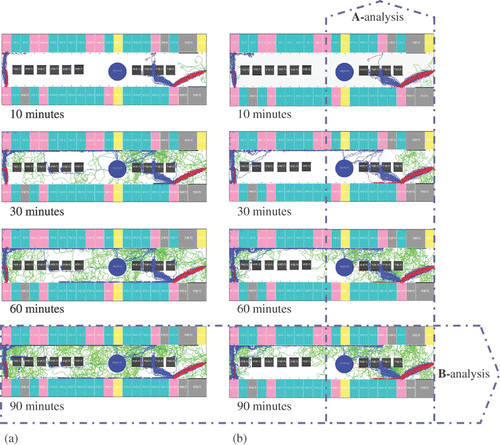
Table 4. Parameter setting of scenario.
5.2. Discussion
Currently, this study aims to discuss the fact that there is a relationship between the former and latter choices of pedestrians regarding urban space. Pedestrians’ shopping behaviors such as which shops to go to first and continuous moving behaviors generated by pedestrians’ attentions are influenced by environments’ attraction. This article thus focuses on the discussion and analyses of the simulation results generated by a proactive agent. Through the above simulation results, we reorganize three subjects, as below: the orientation of the pedestrian's attention in the space, the relationship between the pedestrian's spatial movements and visual distance, and the interactions between attention and street spatial design elements.
5.2.1. A-analysis
5.2.1.1. The orientation of the pedestrian's attention in the space
According to the simulation results in , we found that a pedestrian's attention was oriented by and movement in the space depended upon non-sequential and discrete methods. The proactive agents changed their directions because of detecting new attractive objects; they moved from the shops on the west side to the opposite shops, as shown in . Thus, there are ‘diagonal’ paths. In addition to movement methods, we also found that, when attention movement speed was a uniform motion (the setting of the step distance is the same), longer movement distances will take longer times. Thus, the stationary time at a location selected will be increased; during this process, the number of the attractive objects also indirectly influences the pedestrian's stationary times. Therefore, the placement of the attractive objects will affect the agents’ behavior in a simulated environment, suggesting that sufficient attractive facilities on a street—fountains, entrance signs, outdoor seats, plants, etc. — will attract a pedestrian's attention.
5.2.2. B-analysis
5.2.2.1. The relationship between the pedestrian's spatial movements and visual distance
We compare the simulation results and treat the horizontal visual distance and visual angle as the variables to draw the pedestrian's attention. During the simulation processes, when there are attractive activities, the agents tend to approach. When there are more attractive visual objects on the street, such as new landmarks or shop signs, the proactive-agents’ walking speed will be slower, which changes the agents’ moving angle since selecting the next object determines their moving direction. If they do not find attractive activities or other stimulus, they will continue walking and look for shops or other interesting facilities, as shown in (check the rectangular box). Thus, we conclude that attention moves as serial analogy in the space. While walking, the pedestrians first decide the activity location, determine the direction and distance, and then follow the paths.
5.2.2.2. The interactions between attention and street spatial design elements
After comparing the simulation results, we find that the proactive agents tend to stay and watch attractive facilities in some areas on the street. In other words, because of different destinations and motives, larger visual angles and longer visual distances, the agents will give different attention to the information of spatial structures. Thus, they will first select their priority destinations, and then determine the secondary locations. In addition, the agents’ distribution on the street results from the differences of business types, spatial patterns, and crowd activities. The areas with linear distribution mean they are based on business behaviors, and therefore, the agents shop and pass each other in these areas. Thus, when there are important business activities or artistic performances in front of the shops, the agents tend to be attracted, which results in surface distribution, as shown in (circle here), demonstrating the space for the use of the crowd. In other words, visual attention in the space is the implication of spatial structures. When there are more clues, the pedestrians will have stronger intentions to use the space.
6. Conclusions and suggestions
This article applied the attention theory, based on agent behavior simulation systems, and created agents similar to pedestrians on the street in order to construct a scenario simulation system for urban street designs. From the perspective of professional designers, urban design requires different scenario simulations in order that they can comprehend the characteristics of different plans and present behaviors. This research finds that the pedestrian's stationary and movement behaviors on the street are directed by internal needs and the stimulus of external environments. We can set agent programs to represent pedestrians and further simulate the walking agents’ behavior with different stimuli. With interactions between agents with different attributes and street characteristics, we can reflect a pedestrian's real-time behaviors. The case simulation demonstrates that the method can simulate behavior similar to real cases, and further assist urban designers to evaluate and analyze interactions between pedestrians’ behavior and urban environments to facilitate better design decision-making.
The process of crowd interactive grouping has always been a subject of concern for many psychologists and sociologists. The simulation results in this study showed that the behavior of pedestrian groups not only concerns simple grouping: individual movement in the group often changes due to implications in the environment which gradually affect neighboring individuals, similar to an infection. In an interactive communication of messages among individuals, emergent collective behavior gradually appears. The case simulation aimed to establish an object of attention with attractive nature in the outdoor street environment, assigning it with implications for attention gathering. When pedestrians walk on the street before clues appear, a larger area of attention must be maintained mainly because there is no way to predict where an interesting target will appear. This wider range of attention will also cover the simulated establishment of attention, and therefore, improve the opportunity for selection based on the object. Far away pedestrians gradually move towards the crowd when they see a crowd gathering ahead. Thus, when designers use this system, objects of attention of different natures are established according to the needs of space activity, in order to spread influence to simulate the agent presentation in the environment.
In addition, the defined visible area of attention in this article refers to an activity point which can be reached within an urban open space for pedestrians. A visible area of attention is defined as two-dimensional substantial architecture, street furniture or obstacles; since pedestrians basically move on the ground level, street walking space does not have many height changes. Hence, this study only discussed two-dimensional surfaces. It is suggested that future studies may incorporate three-dimensional space to examine the effect on visible area of attention. Finally, the stimulation behavioral model constructed by this article can be applied to other fields. The designers can adjust the parameters through the system interface to control the agents’ attributes. However, in an interface module, the objectivity of behavior classification and parameter settings is still unsatisfying. On the other hand, we did not construct a database in the system; in addition, we can try to plan several tests on specific targets during simulation. The objects (stimuli) in the environment can be regarded as agents, with different attributes set by the behavioral model of parameters, and one can adjust the optimized interactive model for different scenarios. The interaction among the agents with different attributes on the street is also a direction for future study and discussion.
Acknowledgments
This study was supported by the National Science Council of the Republic of China under grant NSC-97-2511-S-468-001. The author is grateful to Prof. Mao-Lin Chiu for discussing and contributing to this work.
References
- Alexander , C. 1977 . A pattern language , New York : Oxford University Press .
- Arthur , P and Passini , R . 1992 . Way-finding, people, signs, and architecture , New York : McGraw-Hill .
- Batty , M . 2001 . Agent-based pedestrian modeling-editorial . Environment and planning B: planning and design , 28 ( 3 ) : 321 – 326 .
- Berlyne , D . 1960 . Conflict, arousal, and curiosity , New York : McGraw-Hill .
- Berlyne , D . 1976 . Effects of novelty and oddity on visual selective attention . British journal of psychology , 67 ( 2 ) : 175 – 180 .
- Borgers , AWJ and Timmermans , HJP . 1986 . City centre entry points, store location patterns and pedestrian route choice behaviour: a microlevel simulation model . Socio-economic planning sciences , 20 ( 1 ) : 25 – 31 .
- Broadbent , DE . 1958 . Perception and communication , London : Pergamon Press .
- Chen , JL and Stanney , KM . 1999 . A theoretical model of wayfinding in virtual environments: proposed strategies for navigational aiding . Presence , 8 ( 6 ) : 671 – 685 .
- Darken , RP . 1996. Navigating in large virtual worlds. International journal of human-computer interaction, 8 (1), 49–72
- Egly , R , Driver , F and Rafal , RD . 1994 . Shifting visual attention between objects and locations: evidence from normal and parietal lesion subjects . Journal of experimental psychology: general , 123 ( 2 ) : 161 – 177 .
- Gasser , L . 1991 . Social conceptions of knowledge and action: DAI foundations and open systems . Artificial intelligence , 47 ( 1–3 ) : 107 – 138 .
- Goldsmith , M and Yeari , M . 2003 . Modulation of object-based attention by spatial focus under endogenous and exogenous orienting . Journal of experimental psychology: human perception and performance , 29 ( 5 ) : 897 – 918 .
- Helbing , D , Farkas , I and Vicsek , T . 2000 . Simulating dynamical features of escape panic . Nature , 407 ( 6803 ) : 487 – 490 .
- Helbing , D and Molnar , P . 1995 . Social force model for pedestrian dynamics . Physical review E , 51 ( 5 ) : 4282 – 4286 .
- Helbing , D . 2001 . Self-organizing pedestrian movement . Environment and planning B: planning & design , 28 ( 3 ) : 361 – 383 .
- Hewitt , C . 1977 . Viewing control structures as patterns of passing messages . Artificial intelligence , 8 ( 3 ) : 323 – 364 .
- James , W . 1890 . The principles of psychology , New York : Henry Holt .
- Jiang , B . 1999 . SimPed: simulating pedestrian flows in a virtual urban environment . Journal of geographic information and decision analysis (GIDA) , 3 ( 1 ) : 21 – 30 .
- Krieg-Bruckner , B . 1998 . “ A taxonomy of spatial knowledge for navigation and its application to the Bremen autonomous wheelchair ” . In Spatial cognition: an interdisciplinary approach to representing and processing spatial knowledge , Edited by: Freksa , C , Habel , C and Wender , KF . 373 – 398 . Hamburg, Germany : Springer .
- McAndrew , FT . 1993 . Environmental psychology , Pacific Grove, CA : Brooks/Cole .
- Merrill , PF . 1996 . Computers in education, , 3rd , Needham Heights, MA : Allyn & Bacon .
- Passini , R . 1984 . Wayfinding in architecture , New York : Van Nostrand Reinhold .
- Rapoport , A . 1982 . The Meaning of the built environment: a non-verbal communication approach , Beverly Hills, CA : Sage .
- Rapoport , A . 1987 . “ Pedestrian street use: culture and perception ” . In Public streets for public use , Edited by: Vernez Moudon , A . 80 – 94 . New York : Van Nostrand Reinhold .
- Reynolds , CW . 1987. Flocks, herds and schools: a distributed behavioral model. In: Proceeding of the 14th annual conference on computer graphics and interactive techniques. New York: ACM Press, 25–34
- Reynolds , CW . 1999 . Steering behaviors for autonomous characters . In: Proceeding of game developers conference. Miller Freeman Game Group . 1999 , San Francisco, CA. pp. 763 – 782 .
- Sanders , MS and McCormick , EJ . 1993 . Human factors in engineering and design, , 7th , New York : McGRAW-Hill .
- Saunders , R and Gero , JS . 2004 . Curious agents and situated design evaluations . Artificial intelligence for engineering design, analysis and manufacturing , 18 ( 2 ) : 153 – 161 .
- Schelhorn , T . et al., 1999. STREETS: an agent-based pedestrian model. In: Proceeding of computers in urban planning and urban management, 8–10 December, Venice, Italy
- Spencer , C , Blades , M and Morsley , K . 1989 . The child in the physical environment: the development of spatial knowledge and cognition , Chichester : John Wiley and Sons .
- Wooldridge , MJ . 2002 . An introduction to multi-agent systems , Chichester : John Wiley and Sons .
